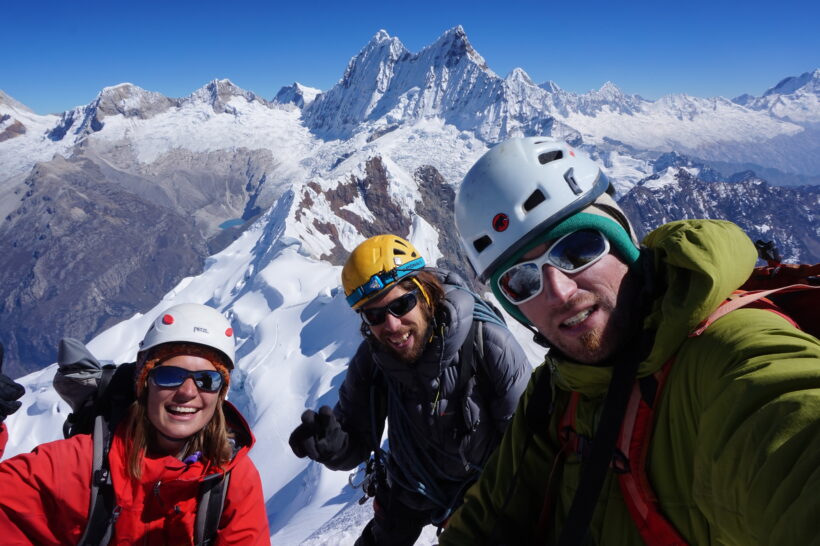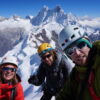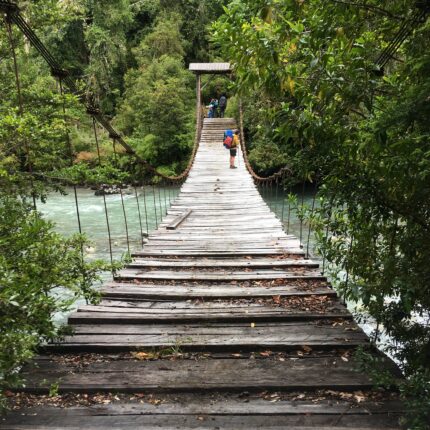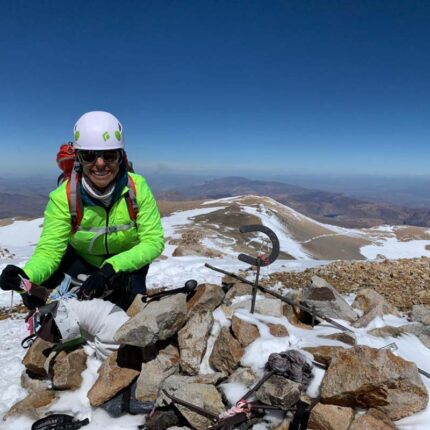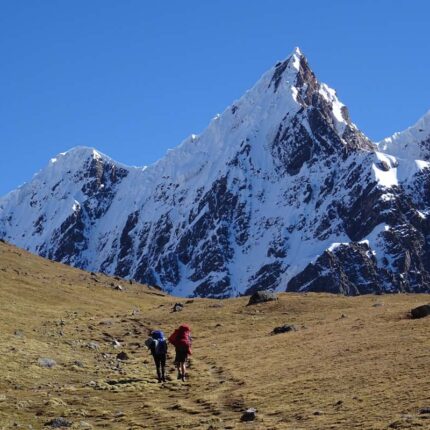The geography, its people, the availability of its mountains, the many itineraries and the quality of its routes make Huaraz worthy of the name “Capital of Andinism in South America”.
The White mountain range is a fraction of the Andes Mountains located in the north-central region of Perú. It owes its name to its many invaluable perpetual-snow covered peaks; most of them dazzlingly massive and beautiful. For the last few decades, it has been a frequent destination for mountaineers around the world that visit Peru every season looking for challenging adventures only found in its high summits.
Located in the Ancash district 408 km north of Lima, the Capital, this mountain range is the highest in Peru. It stretches for 180 km inside the margins of the Huascaran National Park, a natural reservoir declared by UNESCO as a Biosphere Reserve and Natural Patrimony of Humanity.
The many villages that give access to the mountain range are spread across the Huaylas Alley, a narrow valley that runs from south to north between the White and the Black mountain ranges. The tourism capital and the most populated city in the area is Huaraz, located at an average altitude of 3050m., very close to the mountains; in fact, you can enjoy an amazing view of the snow capped Vallunaraju or the shocking Huascarán right from the city’s downtown. This closeness to the snow mountains make this city the perfect place for planning our expeditions to the massifs. Huaraz will be our base camp for this adventure!
When visiting the area you are able to witness how Peru’s andean history and tradition are kept alive, constantly resisting the effects of the Western world and globalization, refusing to die in oblivion. The kindness of its people, the beauty of the landscape and the inevitable cultural shock found in the surroundings of Huaraz, become an attraction.
The large number of valleys, lakes, snow mountains, trails and ascents turn this mountain range into a must-experience destination for mountaineers and trekking lovers.
Our programmes in the area are quite diverse. From 1-day walks, to trekking and many-weeks-long expeditions. Some of the valleys we like to visit are Ishinca, Akilpo, Quilcayhuanca, Santa Cruz, Parón, Llanganuco, Ulta, Rurec, and others. There is an infinite number of itineraries to explore, walks to be shared, challenging ascents and unforgettable climbs.
The option presented hereby includes some altitude adaptation days and then a series of accents. However, do not hesitate to ask for a taylor-made experience!
Entry requirements
A valid passport is needed for entering Peru. Passports must be valid for six months beyond the date the traveler will exit the country. US passports-holders can stay for up to 90 days without a visa.
We recommend that a photocopy of a passport should be made before international trips. Photocopies should be kept in a location other than the actual passport, for extra security. You should also leave a copy along with your emergency contact details.
Travel advisories
Check if there is any advice/warning issued as well as the entry requirements for your destination with your embassy.
Transfers in Perú
Transportation during the programme is, as stated before, by regular bus services.
Arrival at the airport
When arriving in Lima, follow the signs to the arrivals terminal/building. Head to the immigration and passport control desk. You’ll be granted an entry permit in accordance with your visit. Make sure you check the expiration date so that it covers your full stay in Peru .
After picking up your luggage, you should head towards customs. If you have nothing to declare, you can simply proceed through the gate. If you have something to declare, be sure to provide your form to the customs officer so they can scan your luggage. Whether you do or do not have something to declare, bags may be randomly searched upon exit.
Once through customs, you will move onto the arrivals area. Depending on the season and time of the day, you may find larger crowds waiting for their relatives and friends as well as many taxi drivers and travel agency representatives. You should find a desk next to the exit door where you can hire a taxi to your hotel.
Money
The official currency in Peru is the Sol. Check current exchange rates at www.xe.com before your trip. It is essential to bring cash for the trip. ATM machines are not always reliable or might have a low daily withdrawal limit. Usually, ATMs are easy to find both in Lima and Huaraz, but they become increasingly scarce as we leave urban areas.
Most restaurants accept credit cards, but many do not.
Food in the mountains
All the meals served during the expedition are a mix of local and regional products. We are pleased to accommodate to your diet needs and/or allergies.
We recommend packing your snacks of choice for those long days in the mountains. The Same goes for your favorite beverages. Eating well is key for keeping your strength up out in the wild. And to cope with the loss of appetite, the best you can have is a wide variety of food at your disposal, from sweet to sour and salty.
Hotels
In Huaraz, hotels offer all the amenities you might expect: room service, laundry, wi-fi, etc. Our hotel is close to main tourist attractions, unique stores and colorful markets. Plus, it offers a comfortable place to rest in-between activities.
Camping
During our treks and climbs we will be camping. You may find yourself waking up in your tent with a hot cup of tea delivered with a huge smile on our face, or playing cards with your new friends in the dining tent during tea-time or even enjoying an excellent meal, specially cooked by our staff.
Travel and rescue insurance
An insurance plan is mandatory to protect yourself from the unexpected. Check with your insurance company on the details about coverage and policies. Feel free to contact us for details or in doubt
Location: Huaraz, Perú
Duration: 15 days
Dates: May to July
Requirements: Ideal – Experience in trekking, camping and glacier transit. Good physical condition.
Guides and Ratio: 3:1
9 people max.
- Professional AAGM/UIMLA Mountain Guide + UIAGM Mountain Guide
- Bus tickets Lima – Huaraz – Lima
- Accommodation in Huaraz and transfers.
- Chef
- Passes to Huascaran National Park.
- All meals as noted on the daily itinerary (see exceptions)
- Loads transportation in mules or horses
- All shared gear for the expedition (sleeping tents, stoves and cooking gear, radio, etc).
- Private transfer from Huaraz
- Satellite communication service
- Flights and accommodations in Lima, Perú.
- Transportation from Lima Airport
- Meals besides what is included on expedition days
- Personal gear (sleeping bag, layered clothing, boots, skis)
- Traveler insurance
- Tips
- Alcoholic Beverages
- Some unspecified item in this programme

